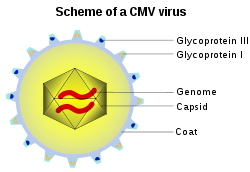- Viral envelope
-
 Schematic of a Cytomegalovirus
Schematic of a Cytomegalovirus
Many viruses (e.g. influenza and many animal viruses) have viral envelopes covering their protein capsids.[1] The envelopes typically are derived from portions of the host cell membranes (phospholipids and proteins), but include some viral glycoproteins. Functionally, viral envelopes are used to help viruses enter host cells. Glycoproteins on the surface of the envelope serve to identify and bind to receptor sites on the host's membrane. The viral envelope then fuses with the host's membrane, allowing the capsid and viral genome to enter and infect the host.
Usually, the cell from which the virus itself buds will often die or be weakened, and shed more viral particles for an extended period. The lipid bilayer envelope of these viruses is relatively sensitive to desiccation, heat, and detergents, therefore these viruses are easier to sterilize than non-enveloped viruses, have limited survival outside host environments, and typically must transfer directly from host to host. Enveloped viruses can cause persistent infections.
Contents
Examples
Classes of Enveloped Viruses that contain Human Pathogens:
DNA viruses
- Herpesviruses
- Poxviruses
- Hepadnaviruses
RNA viruses
- Flavivirus
- Togavirus
- Coronavirus
- Hepatitis D
- Orthomyxovirus
- Paramyxovirus
- Rhabdovirus[2]
- Bunyavirus
- Filovirus
Retroviruses
- Retroviruses
- Hepadnavirus
See also
Bacterial capsule
References
- ^ "CHAPTER #11: VIRUSES". http://www.slic2.wsu.edu:82/hurlbert/micro101/pages/Chap11.html. Retrieved 2008-11-07.
- ^ "The Rabies Virus". http://www.cdc.gov/rabies/virus.html. Retrieved 2008-11-07.
External links
- "Virus Structure". Molecular Expressions: Images from the Microscope. http://micro.magnet.fsu.edu/cells/virus.html. Retrieved 2007-06-27.
Microbiology: Virus Components Viral life cycle Genetics Other Viral disease · Laboratory diagnosis of viral infections · Viral load · Viral quantification · Antiviral drug · Bacteriophage · Neurotropic virus · Oncovirus · History of virusesDNA RNA capsid: matrix protein (M1 protein) · viral envelope (M2 protein)
glycoprotein: Influenza hemagglutinin · NeuraminidaseParainfluenzaParainfluenza hemagglutinin-neuraminidaseRSVRespiratory syncytial virus G proteinRT VSPs: gag · pol (Integrase, Reverse transcriptase, HIV-1 protease) · env (gp120, gp41)
VRAPs: transactivators (Tat, Rev, Vpr) · Nef · Vif · VpuFusion protein Categories:
Wikimedia Foundation. 2010.
